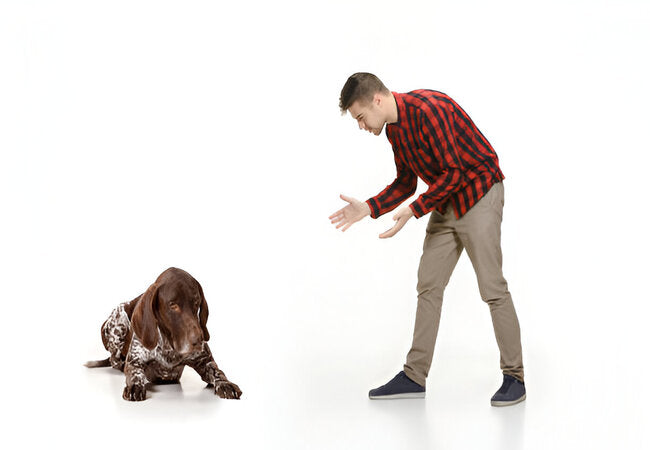Why Your Behavior May Be Causing Your Nervous Dog—Vet Guide 2025 🐕🧠

In this article
Why Your Behavior May Be Causing Your Nervous Dog—Vet Guide 2025 🐕🧠
By Dr. Duncan Houston BVSc
🐾 Our dogs are incredible mirrors—they pick up our moods, body language, and stress levels. In 2025, science continues to show that when we’re anxious, our furry companions start to feel anxious too. Let’s explore how your behavior might be fuelling your dog’s jitters and what proactive steps you can take as a caring owner—and as a vet—to calm them down.
1. Emotional Contagion: Anxiety “Down the Leash”
Research in the Journal of Veterinary Behavior confirms dogs pick up their owners’ stress, coined “transmitted down the leash.” Signs include elevated heart rate and fearful behaviors. Similarly, professionals observe more anxious dogs among high‑stress clients. Simply put: when you're tense, so is your dog!
2. The Feedback Loop: Panic Breeds Panic
Veterinary nurse Frankie Jackson and vet Dr Becky Peters note our stress affects dogs through body language, tone, and scent—creating a cycle where the dog becomes more anxious, which then worries us more.
They warn against over‑comforting pets in phobic states (“it’s okay!” in a high‑pitch voice), which can reinforce fear. Calm, quiet reassurance works better.
3. Routines & Socialization: Pandemic Puppies’ Dilemma
Many "pandemic pups" missed critical social stages between 3–14 weeks, leading to later anxiety and separation issues. As life stabilizes in 2025, efforts to help these dogs adapt to normal routines are essential.
4. Signs Your Dog is Picking Up Your Mood
- Restlessness, pacing, whining
- Excessive grooming, yawning, lip-licking
- Hiding or avoidance
- Increase in fearful responses—cowering, trembling, barking
Veterinary behaviorists recommend you monitor these signs, especially following stressful events like vet visits, fireworks, or thunderstorms.
5. Owner Behavior: What Helps and What Hurts
- Stay calm: Avoid anxious speech or frantic gestures in tense moments.
- Neutral goodbyes: Low-key departures and arrivals help teach independence.
- Confidence ups routines: Predictable mealtimes, walks, and rest build security.
- Encourage alone time: Practice short absences, building up from a few minutes to an hour or more.
- Use counterconditioning: Pair triggers (e.g., thunder, the doorbell) with high-value treats over time.
- Provide stimulation: Mental enrichment via puzzles, scent games, or tools from Woopf can reduce anxiety.
6. Veterinary & Behaviorist Intervention
If anxiety persists despite home strategies, a vet exam is essential to rule out medical issues.
Behavior modification—like desensitization and structured training—is vital. A certified behaviorist or veterinary behaviorist often integrates these methods with calming supplements, pheromones (e.g., Adaptil for dogs, Feliway for cats), and, where needed, medications like SSRIs or benzodiazepines.
7. Nutrition, Environment & Home Prep
Ensure your dog’s basic needs—exercise, rest, nutrition—are reliably met. Anxiety can lower immunity and disrupt digestion.
Create a calm space: soothing music, pheromone diffusers, and hiding places can reduce noise‑phobia reactions. Before thunderstorms or events, add extra mental/physical activity and prepare comfort tools.
8. Owner’s Mental Health Matters Too 🧘♂️
Your well-being directly affects your dog. Studies find that dogs with behavior issues can worsen owner mental health, and vice versa.
“Crossover stress”—especially work-related anxiety—can transfer to your pet. Owners need to manage their stress through mindfulness, exercise, and taking breaks to support their pet’s emotional health.
9. Ask A Vet Support & Tools
At Ask A Vet, we offer 24/7 behavioral consults, training plans, and tools like Woopf enrichment puzzles and Purrz calming aids—tailored to break stress cycles and rebuild confidence. Use our app to track progress, set routines, and access expert help anytime.
10. 2025 Action Plan 🗓️
- 🙏 Practice calm energy—your dog will follow your lead.
- 📋 Build structure: schedule exercise, meals, and training.
- 💤 Encourage safe alone time daily.
- 🍖 Use counterconditioning—high-reward snacks = comfort.
- 🩺 Consult your vet if signs persist.
- 📱 Use Ask A Vet tools—support is just a tap away.
FAQs 💬
• Can my stress hurt my dog long‑term?
Yes, chronic stress can lead to anxiety disorders, weakened immune response, and behavioral issues. Reducing stress benefits both of you.
• Should I avoid leaving the house?
No—gradual alone time builds resilience. Combine with enrichment and calming tools.
• Will calming meds fix this?
Medication can help—but only alongside behavior work and environmental changes.
• What if I can’t handle my own anxiety?
Get support! Improving your wellness is crucial for your dog. Seek therapy, mindfulness programs, or peer support while you work together.
Conclusion ❤️
In 2025, it’s clear that your emotional state and habits shape your dog’s well-being. By managing your stress, creating calm routines, and providing targeted support—with help from Ask A Vet, Woopf, and Purrz—you can break anxious cycles and foster a confident, happy companion. You’ve got this—together. 🐾
Need expert support? Visit AskAVet.com and download the Ask A Vet app now for personalized help anytime.






